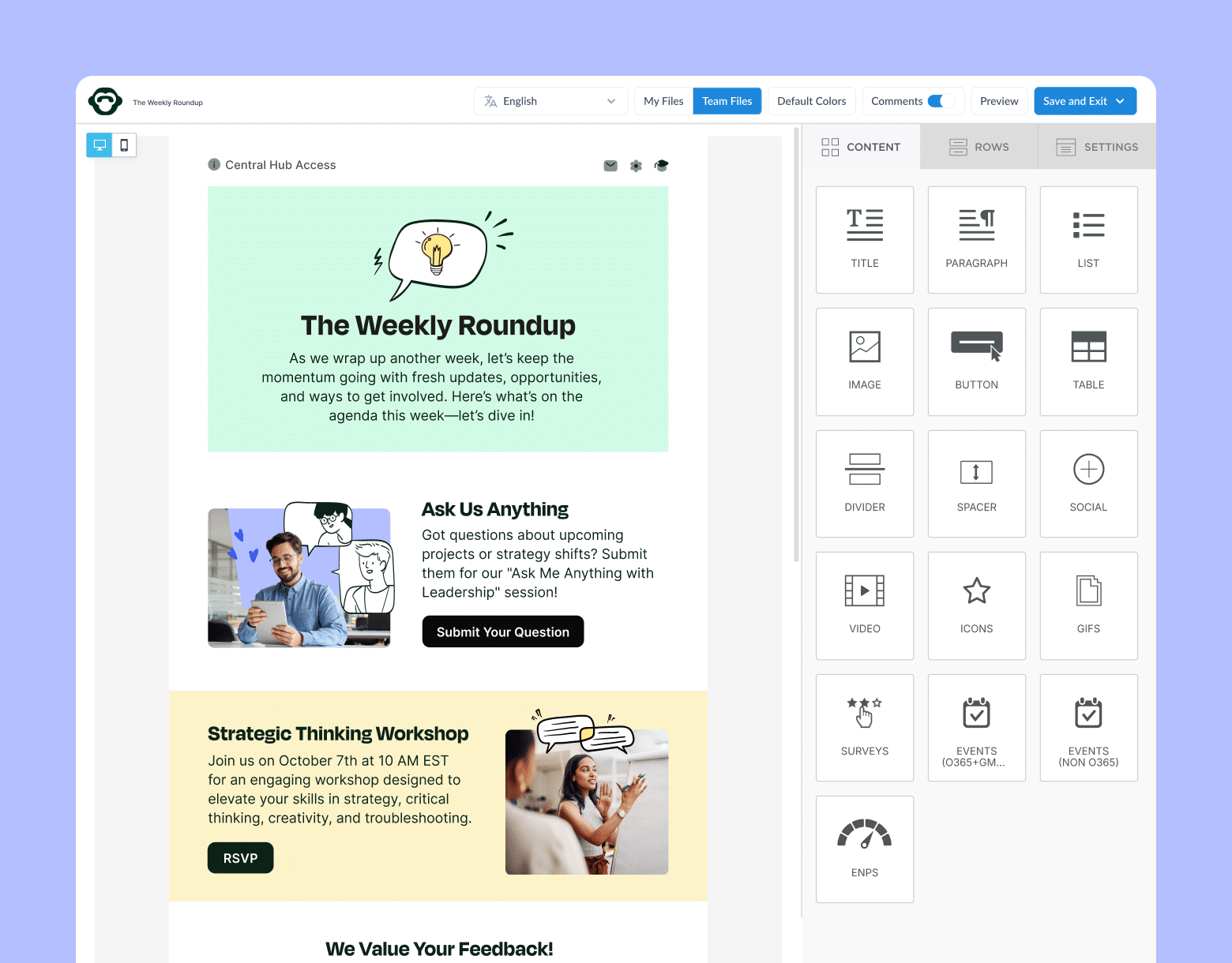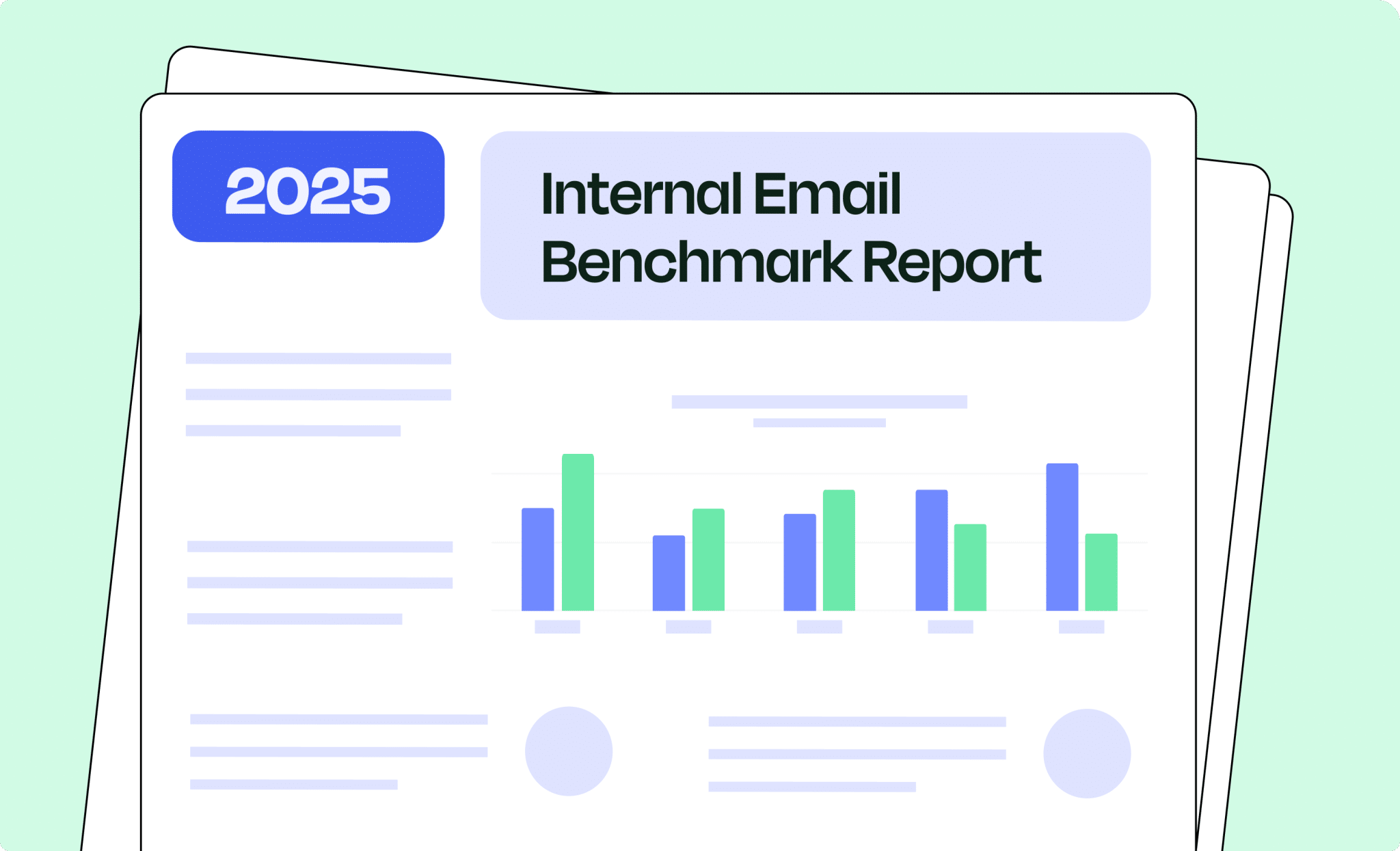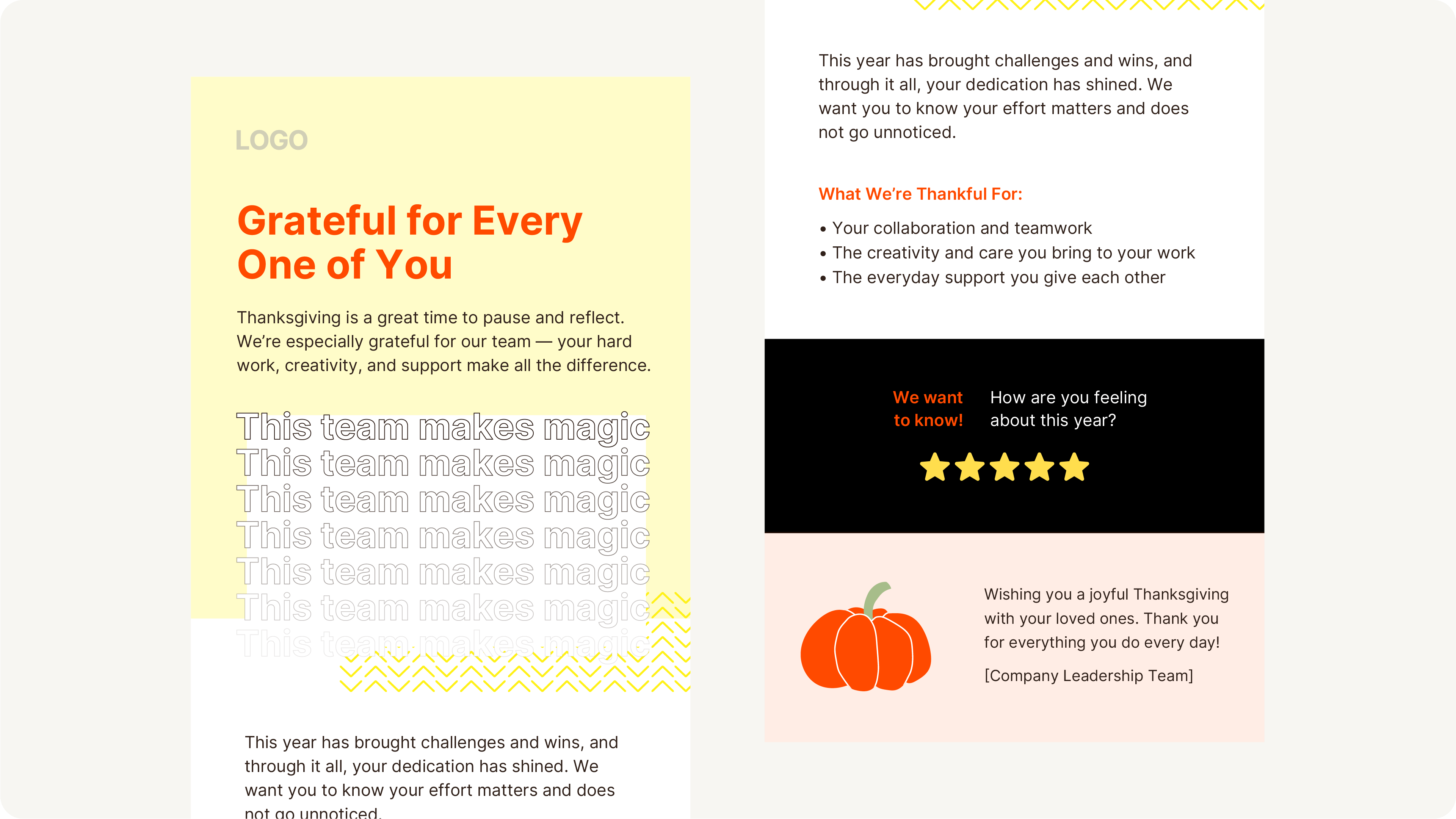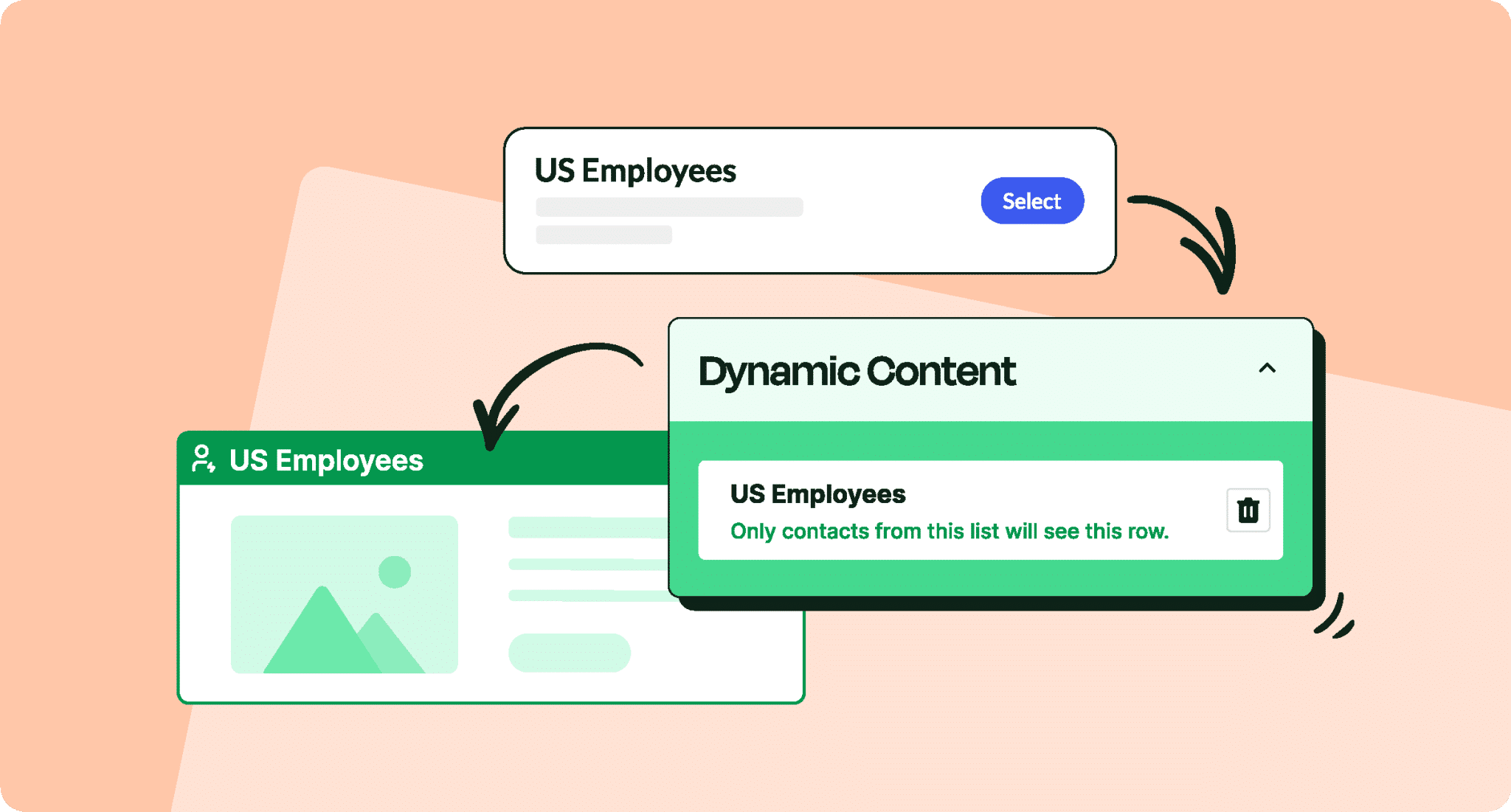Worried that your internal newsletter is getting lost under a stack of unread emails? We’ll show you how to get employees to open emails through more engaging, purposeful, and timely content.
Your workforce wants to feel informed about what’s going on across the company. Senior leadership teams want key messages to be seen and heard. So where does it all go wrong?
Most of the time, the problem isn’t a lack of interest in your internal emails. When it comes to low email open rates, the culprit tends to be poor presentation and bad timing.
This guide will teach you how to get employees to open emails and build lasting engagement with your audience.
Take self-guided tour of ContactMonkey
See how our key features can streamline your internal communications.
Take product tour

15 Proven Strategies That Will Get Staff To Read Important Emails
Getting employees to open and read your emails in full is no small feat. Below, we break down some strategies that can help guide you in the right direction. ContactMonkey’s internal email platform make it easy to get these actionable strategies in place within your organization and improve employee email engagement.
1. Start with a captivating subject line
Your email subject line is the first touchpoint between your newsletter and your employees.
In order to stand out, your headline needs to allow employees to easily answer the question, “What’s in it for me?”
In our recent webinar with Brilliant Ink, the internal communications consultancy reported a 20% – 35% increase in open rates when the subject line included features or highlights that a reader could genuinely look forward to.
Likewise, incorporating stats, employee names, engaging employee newsletter names, and even emojis all improved the chances of internal emails being opened.
2. Keep readers hooked
Once your subject line gets employees past the threshold, your content is responsible for keeping them hooked.
When developing your email copy, ask yourself: is my content relevant? Interesting? What value does it bring to my employees? Once you’re able to confidently answer these questions, proceed to creating a rough draft of your copy.
To optimize your content, try using an email collaboration tool—it’s like Google docs for internal emails. You’ll quickly get an extra set of eyes on your email copy and other departments can easily contribute and edit content.
You can also build custom internal email lists to target employees with only relevant content. Using ContactMonkey’s List Management feature, you can create custom email lists without requiring IT approval. Your lists can be integrated with your existing Human Resource Information System (HRIS) like Workday and ADP, as well as Azure Active Directory, so they’ll update automatically as employees join and leave your organization.
Build engaging, interactive employee emails in minutes
Build amazing emails quickly and easily using our drag-and-drop template builder. No design or technical expertise needed.
Explore email builder

3. Make content scannable
The moment employees see a wall of text they’re closing that email window immediately. Nobody has time for that. To avoid overwhelming your staff, make your content simple to read and easy to scan.
Research shows that emails with 200 words have the highest click-through rates. While it’s understandable that some topics will require a bit more detail, you can still make your content more digestible. Start by breaking up text into small, bite-sized chunks, keeping sentences short, and using bullets where possible.
If you’re using HTML newsletters, it’s much easier to make your content reader-friendly. Dividers, headers, text blocks, and buttons will let enable you to add more copy while ensuring that content never looks crowded.
🐒PRO TIP: Learn about the many benefits of using an internal email tool like ContactMonkey vs Mailchimp for your internal communications.
4. Make your content more engaging
If you’re wondering how to get employee emails read, focus on creating content that you yourself would want to read.
Is your content relatable? Does it convey a tone and style that resonates with your audience and internal brand? Answering a resounding ‘Yes!’ to these questions will help you get employees to open and read your new emails.
Avoid jargon and use simple language that employees can actually understand. If there’s a term only your IT team will know, avoid it. Your email should clarify things, not confuse employees further. And when it comes to rich, persuasive writing, learn how to practice effective internal communications storytelling to really draw your readers in.
Need new ideas for your email content? With ContactMonkey’s ChatGPT integration, you can describe what kind of content you want and our integration will create example copy for you to edit and customize for your audience.
5. Choose an engaging email layout and structure
There are certain layouts that simply appeal more to the human eye. So if you’re wondering how to get employees to read your emails, you’ll have to get familiar with email newsletter design best practices.
Email layouts that follow the F or Z structure help readers scan content more easily and intuitively. But no matter which shape you choose, always build out your layout with a visual hierarchy in mind. Organize components of your email according to good internal email design principles to capture reader attention.
By keeping the key facts at the top, you ensure that key deadlines, surveys, and policy updates have a bigger chance of reaching employees.
Take self-guided tour of ContactMonkey
See how our key features can streamline your internal communications.
Take product tour

6. Use CTAs wisely
Getting employees to open your email is just half the challenge. If you’re wondering how to get employees to read your emails and click on key resources it’s important to create clear, captivating CTAs (call-to-actions).
With ContactMonkey’s HTML email template builder, you can add buttons and banners that show readers exactly where to click.
Meanwhile, headers, dividers, and customizable graphics graphics will help guide employees to the most captivating info in your email. As the email journey becomes more intuitive, employees will be more likely to go where you want to take them. So make the roadmap clear with high-quality, internal email templates.
7. Add meaningful, high-resolution visuals
Captivate your reader’s attention by making great visuals part of your email newsletter checklist.
Images help clarify information and make it more memorable. In fact, some studies suggest that images are more likely to be remembered than words, since our brain dually encodes images, while only encoding words once.
To be effective, your visuals should always complement your content rather than distract or confuse readers. Adding images for the sake of it is never a good idea.
Opt for infographics that help explain a concept that your newsletter touches upon. For instance, you can create a step-by-step visual guide for your company’s return to the office (RTO) plans, or make a video tutorial for using the new office software. With ContactMonkey, you can add images, videos, GIFs, and tons of other graphics into your internal email.
8. Use incentives
Hey, we’re not suggesting that you bribe your employees into reading your emails. But giving away the occasional freebie or gamifying your internal email content can do wonders for your email open rates.
If your email engagement is in dire need of a boost, incorporate giveaways and contests like “Guess the desk” into your newsletter strategy. Simply ask employees to share photos of their home office setup. Then, publish the photos in your internal newsletter and use email-embedded employee surveys to get staff guessing who the desk owner might be.
Introduce prizes for the first correct guess, such as Amazon gift cards, to boost participation. And don’t forget to promote your efforts across your other internal communications channels to get more people tuning into your employee newsletters.
9. Personalize your emails
A personalized email is a great way to get employees opening your emails. It’s the type of communication that addresses individual recipients by name—either in the subject line, header, body copy, or all of the above.
The nice thing about personalized emails is that they make your communications more direct, friendly, and intimate. Not to mention, an email that addresses employees directly will stand out much more in a jam-packed inbox.
Best of all: personalized emails are easy to make. Learn how to create personalized internal emails with the help of ContactMonkey’s intuitive internal email template builder.
Watch ContactMonkey LIVE in action
Join live demo

10. Ask employees for feedback to improve your internal emails
Tried different strategies and still found yourself wondering how to get employees to open your emails? Why not enlist employees to help!
An easy way to get ideas for improving your internal emails is by asking your workforce for suggestions. Using the best pulse survey software like ContactMonkey, you can embed polls and employee feedback boxes straight into employee newsletters.
Ask employees to rate their favourite types of content or provide suggestions using anonymous comments. Then, use your survey results to break down preferences and divide them into “essential,” “useful” and “nice-to-have” content. Once you’ve got the data, it becomes easier to create content that your employees actually care about.
Read our list of the best ways to use employee surveys in internal emails to gather valuable feedback.
11. Reflect your employer branding
Your employer brand reflects how employees and job seekers perceive your brand. It’s also responsible for providing a framework for your company culture and uniting employees behind a common mission and values.
A captivating employee newsletter will help reflect your employer brand through appropriate language, tone of voice, colours, and copy. When internal content conveys the employer brand well, employees will look to your newsletter as a resource for aligning themselves with their team and contributing to the workplace community.
Use branded email templates to showcase your employer brand across internal emails with ContactMonkey.
12. Appeal to FOMO
Never underestimate the power of “FOMO”(fear of missing out) to get employees to open and read your emails.
Offering breadcrumbs, teasers, and other hints about exciting news in your internal newsletter is a great way to get employees to open your communications.
Leverage your other asynchronous communications channels, such as Slack, to promote internal email content and create a feedback loop between the different mediums. You could publish a snippet of your newsletter on the company intranet, or offer a one-liner such as “You’ll never guess what we’ve got in store for September…”
These tidbits get employees excited about opening your emails and give your internal email open rates an easy boost.
13. Segment your employee emails
Segmenting your emails is one of the best ways to get employees to open and read your emails.
By dividing email subscribers into smaller segments with common criteria you can create content that’s customized to specific teams, departments, or office locations.
For example, say you have staff across regions with different languages. By segmenting your internal communications, you can create multilingual employee emails and send them to specific email lists.
This sort of tailored approach to internal communications ensures your employees are always receiving content that’s relevant to their roles and needs.
Modern internal comms and measurement tools
No design or technical expertise needed. Save time, increase engagement, and dazzle your employees with fun and interactive communications.
Explore all features

14. Send emails at the best time
So you’ve created an amazing employee email: catchy headline, great layout, stunning visuals—the works. Does this guarantee that your employees will open and read your email? Unfortunately not.
If you’re bulk sending emails late at night, early in the morning, or in the middle of lunch, don’t expect high email open rates.
For companies with employees around the globe or working remotely, things get even more complicated. Schedules will vary, so high open rates in one location might mean low open rates in another.
To send emails at the best time it’s essential to use an email tracking and scheduling tool that helps you find a sweet spot in terms of engagement. Use ContactMonkey to identify the exact times when most employees are engaged and schedule a send on Gmail or Outlook accordingly.
15. Use an all-in-one internal email tool
A guaranteed way to increase your internal email open rates: providing employees with a one-stop-shop for all their informational needs. Start using the best internal email platform to improve internal comms performance.
ContactMonkey’s internal messaging software leverages all the best parts of email while amplifying its capabilities. With the power of HTML elements, ContactMonkey lets you embed smart links, videos, and other interactive elements straight into your internal emails.
Dividers, banners, and CTAs let you organize content in a way that makes emails easy to navigate. So you can deliver more value across your internal emails without skimping on visual appeal and readability.
You’ll also have the power to consistently track and measure email engagement and performance with ContactMonkey’s powerful email analytics.
And if you’re worried about frontline employee engagement, ContactMonkey also lets you create and send employee SMS messages. Not to mention, its users are able to send internal texts from the very same place where they create and build emails. So you can use email and sms together for a stronger internal communications ecosystem.
Are You Tracking Internal Emails and Newsletters?
Trying to make improvements to your internal emails without tracking them is like setting out on a road trip without a GPS. You might know your destination and the general direction where you should be headed. But without a roadmap to guide your journey and take you through the twists and turns, it’s a lot harder to get to where you’re going.
Email metrics provide a roadmap for your internal communications plan. They indicate the type of content you should invest in, and where you could take a few shortcuts.
With an email tracking tool like ContactMonkey, you can conduct internal communications audits to identify high-performing areas across your internal emails.
Using ContactMonkey’s Reporting feature, you’ll be able to keep track of employee likes and dislikes over time, and sort your email metrics using different criteria, or segments. Also, you can zero in on what links your employees are clicking on with our click map reports.
You might notice that employees absolutely love the ‘Top ten’ feature in your internal newsletter. Or you might see that there isn’t much interest in your new change management survey.
Once you tap into employee preferences, you can start brainstorming ways to make the boring content come to life and repurpose that high-performing content elsewhere.
Learn more about leveraging the most helpful internal email reports.
How to Track Internal Emails
How can you tell if someone read your email? What about whether they clicked on important links or filled out your email pulse survey?
Companies like Chobani, Exemplis, and IKEA have turned to ContactMonkey in order to better understand employee engagement patterns and preferences.
“We’re averaging a 70% open rate on our weekly communication to the team with click rates between 20 – 30%. Before using ContactMonkey we wouldn’t have any of that data.”- Corey Kachigan, Exemplis
With ContactMonkey’s internal email analytics features, click rates, read times, and even employee comment data are all accessible through a sleek dashboard system.
When you have the necessary data, you can begin to formulate an internal communications plan to drive strategic improvements and get those open and read times growing.
Benefits of Tracking Internal Email Engagement
Email tracking lets you know the state of your current internal communications plan, what you’re doing well, and what opportunities you might be missing. A performance based approach is going to help you get internal email best practices firmly in place.
If your email open rates are low but read times are high, it might mean that your main issue is getting employees in the door. Most likely, your email subject lines may be the root of the problem.
On the other hand, high open rates and low click-through rates indicate that you have a problem with your email copy or design. Knowing these issues will help you create an informed action plan for improving your emails going forward. Can you see why internal email analytics is important to guiding your internal comms success?
And when it’s time to ask for a bigger internal communications budget and show the ROI on employee engagement, the data will become even more valuable.
Follow these best practices for internal email analytics and take your email optimization game to the next level.
What Email Metrics Should You Track?
There are a number of email metrics you can track. But we recommend focusing on 3 core metrics to guide your internal email strategy:
- Open rates: This is the percentage of recipients who opened an email out of the total number of recipients.
- Click-through rates: The percentage of recipients who clicked on specific links in an email out of the total number of unique opens.
- Read times: How long employees actually spend reading your content. This metric is important because it shows whether your email content is actually interesting/valuable to readers.
Featured Resource: Internal Email Benchmark Report 2025

What is a Good Open Rate for Internal Email Campaigns?
In our 2025 Internal Email Benchmark Report, we surveyed 43,000+ internal email campaigns from companies across 18 different industries. What we found was that the average email open rate stood at around 70%. Learn more about how you can leverage internal email benchmarks.
That being said, we also learned that internal email open rates vary widely. So it’s difficult to establish a hard and fast target when it comes to optimal open rates.
In fact, our report tracked open rates ranging from 29% all the way to 80%. Differences in industry type, email subject matter, and the type of communications (crisis comms vs. a holiday invite) all account for variations in open rate.
Nonetheless, there are general best practices that can keep your email open rates on the high end no matter what type of content you’re sending out.
Read below to learn how to write a mass email to employees that they actually want to open (and read)! Also, be sure to check out our internal email checklist for more actionable employee communication tactics.
See Guaranteed Improvements to Your Internal Email Open Rate With ContactMonkey
How do you get your employees to read your emails? By offering value across your internal emails and promoting your content in thoughtful and creative ways. Dive into your email metrics and tracking open rates to develop data-backed email engagement strategies attuned to the needs of your workforce.
If you want to learn how to get employees to open emails, start tracking your internal communications with ContactMonkey’s high-performance email builder and analytics software. Book your free demo to see ContactMonkey in action today.



